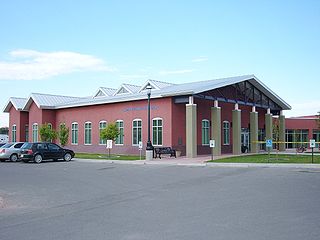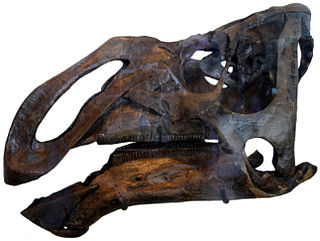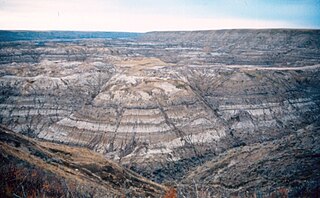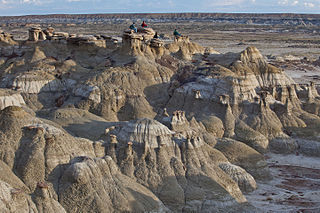
Aztec is a city in, and the county seat of, San Juan County, New Mexico, United States. The city population was 6,126 as of the 2022 census. The Aztec Ruins National Monument is located on the north side of the city.

Pentaceratops is a genus of herbivorous ceratopsid dinosaur from the late Cretaceous Period of what is now North America. Fossils of this animal were first discovered in 1921, but the genus was named in 1923 when its type species, Pentaceratops sternbergii, was described. Pentaceratops lived around 76–73 million years ago, its remains having been mostly found in the Kirtland Formation in the San Juan Basin in New Mexico. About a dozen skulls and skeletons have been uncovered, so anatomical understanding of Pentaceratops is fairly complete. One exceptionally large specimen later became its own genus, Titanoceratops, due to its more derived morphology, similarities to Triceratops, and lack of unique characteristics shared with Pentaceratops.
Spencer George Lucas is an American paleontologist and stratigrapher, and curator of paleontology at the New Mexico Museum of Natural History and Science. His main areas of study are late Paleozoic, Mesozoic and early Cenozoic vertebrate fossils, stratigraphy, and continental deposits, particularly in the American Southwest. His research has taken him on field trips to northern Mexico, Costa Rica, Nicaragua, Jamaica, Kazakhstan, and Georgia, and he conducted extensive field and museum research in China in the 1980s and 1990s. He has written more than 500 scientific contributions, three books, and has co-edited 14 books.

Kritosaurus is an incompletely known genus of hadrosaurid (duck-billed) dinosaur. It lived about 74.5-66 million years ago, in the Late Cretaceous of North America. The name means "separated lizard", but is often mistranslated as "noble lizard" in reference to the presumed "Roman nose".

Badlands Dinosaur Museum in Dickinson, North Dakota, United States, reopened on May 17, 2016, after over twenty years operating as Dakota Dinosaur Museum. It is part of the museum complex at Dickinson Museum Center.

Anasazisaurus is a genus of saurolophine hadrosaurid ("duckbill") ornithopod dinosaur that lived about 74 million years ago, in the Late Cretaceous Period. It was found in the Farmington Member of the Kirtland Formation, in the San Juan Basin of New Mexico, United States. Only a partial skull has been found to date. It was first described as a specimen of Kritosaurus by Jack Horner, and has been intertwined with Kritosaurus since its description. It is known for its short nasal crest, which stuck out above and between its eyes for a short distance.

Nodocephalosaurus is a monospecific genus of ankylosaurid dinosaur from New Mexico that lived during the Late Cretaceous in what is now the De-na-zin member of the Kirtland Formation. The type and only species, Nodocephalosaurus kirtlandensis, is known only from a partial skull. It was named in 1999 by Robert M. Sullivan. Nodocephalosaurus has an estimated length of 4.5 metres and weight of 1.5 tonnes. It is closely related and shares similar cranial anatomy to Akainacephalus.

The Horseshoe Canyon Formation is a stratigraphic unit of the Western Canada Sedimentary Basin in southwestern Alberta. It takes its name from Horseshoe Canyon, an area of badlands near Drumheller.

The Rochester Museum & Science Center (RMSC) is a museum in Rochester, New York, dedicated to community education in science, technology and local history. The museum also operates the Strasenburgh Planetarium, located next to the museum, and the Cumming Nature Center, a 900-acre (3.6 km2) nature preserve near Naples, New York. The museum resides at 657 East Ave. and has a collection of 1.2 million artifacts.

Chasmosaurinae is a subfamily of ceratopsid dinosaurs. They were one of the most successful groups of herbivores of their time. Chasmosaurines appeared in the early Campanian, and became extinct, along with all other non-avian dinosaurs, during the Cretaceous–Paleogene extinction event. Broadly, the most distinguishing features of chasmosaurines are prominent brow horns and long frills lacking long spines; centrosaurines generally had short brow horns and relatively shorter frills, and often had long spines projecting from their frills.

The Arizona Museum of Natural History located in Mesa, Arizona, is the only natural history museum in the greater Phoenix area. It exhibits the natural and cultural history of the Southwestern United States.

The Bisti/De-Na-Zin Wilderness is a 45,000-acre (18,000 ha) wilderness area located in San Juan County in the U.S. state of New Mexico. Established in 1984, the Wilderness is a desolate area of steeply eroded badlands managed by the Bureau of Land Management, except three parcels of private Navajo land within its boundaries. The John D. Dingell, Jr. Conservation, Management, and Recreation Act, signed March 12, 2019, expanded the Bisti/De-Na-Zin Wilderness by approximately 2,250 acres.

The New Mexico History Museum is a history museum in Santa Fe, New Mexico. It is part of the state-run Museum of New Mexico system operated by the New Mexico Department of Cultural Affairs. Opened in 2009, the museum houses 96,000 square feet (8,900 m2) of permanent and rotating exhibits covering the history of New Mexico from ancient Native American cultures to the present.
The Williams Fork Formation is a Campanian (Edmontonian) geologic formation of the Mesaverde Group in Colorado. Dinosaur remains are among the fossils that have been recovered from the formation, most notably Pentaceratops sternbergii,. Other fossils found in the formation are the ammonite Lewyites, neosuchian crocodylomorphs, and the mammals Glasbius and Meniscoessus collomensis.

Bistahieversor, also known as the "Bisti Beast", is a genus of basal eutyrannosaurian theropod dinosaur. The genus contains only a single known species, B. sealeyi, described in 2010, from the Late Cretaceous of New Mexico. The holotype and a juvenile were found in the Hunter Wash Member of the Kirtland Formation, while other specimens came from the underlying Fossil Forest member of the Fruitland Formation. This dates Bistahieversor approximately 75.5 to 74.5 million years ago during the Campanian age, found in sediments spanning a million years.

Titanoceratops is a controversial genus of herbivorous ceratopsian dinosaur. It was a giant chasmosaurine ceratopsian that lived in the Late Cretaceous period in what is now New Mexico. Titanoceratops was named for its large size, being one of the largest known horned dinosaurs and the type species was named T. ouranos, after Uranus (Ouranos), the father of the Greek titans. It was named in 2011 by Nicholas R. Longrich for a specimen previously referred to Pentaceratops. Longrich believed that unique features found in the skull reveal it to have been a close relative of Triceratops, classified within the subgroup Triceratopsini. However, other researchers have expressed skepticism, and believe "Titanoceratops" to simply be an unusually large, old specimen of Pentaceratops.

Ah-Shi-Sle-Pah Wilderness is located in San Juan County, New Mexico, between Chaco Canyon and the De-Na-Zin Wilderness. Its name is a phonetic transliteration of Navajo "áshįįhłibá" meaning "salt, it is grey ". The wilderness has multicolored badlands, sandstone hoodoos, petrified wood and dinosaur bones, similar to those found in the nearby Bisti Badlands and De-Na-Zin Wilderness.
Dinosaur paleobiogeography is the study of dinosaur geographic distribution, based on evidence in the fossil record.

Menefeeceratops is a genus of ceratopsid dinosaur from the Menefee Formation in New Mexico, United States. It is potentially the oldest known member of the ceratopsids, as well as the centrosaurine subfamily, related to animals including Yehuecauhceratops and Crittendenceratops. The type and only species is Menefeeceratops sealeyi, known from a partial, non-articulated skeleton.

Bisticeratops is a genus of chasmosaurine ceratopsian from outcrops of the Campanian age Kirtland Formation found in the Bisti/De-Na-Zin Wilderness in northwestern New Mexico, United States. The type and only species is B. froeseorum, known from a nearly complete skull.























